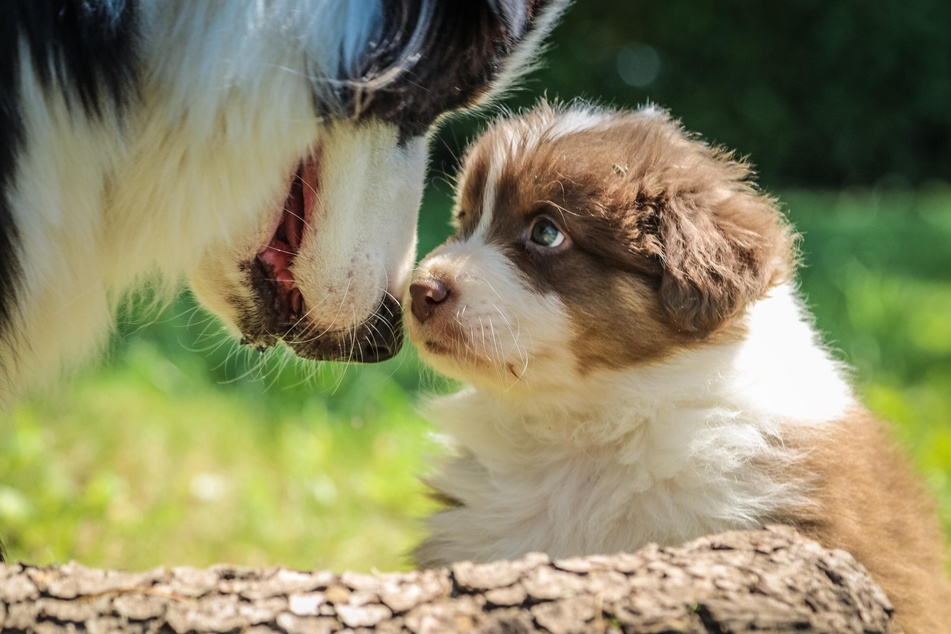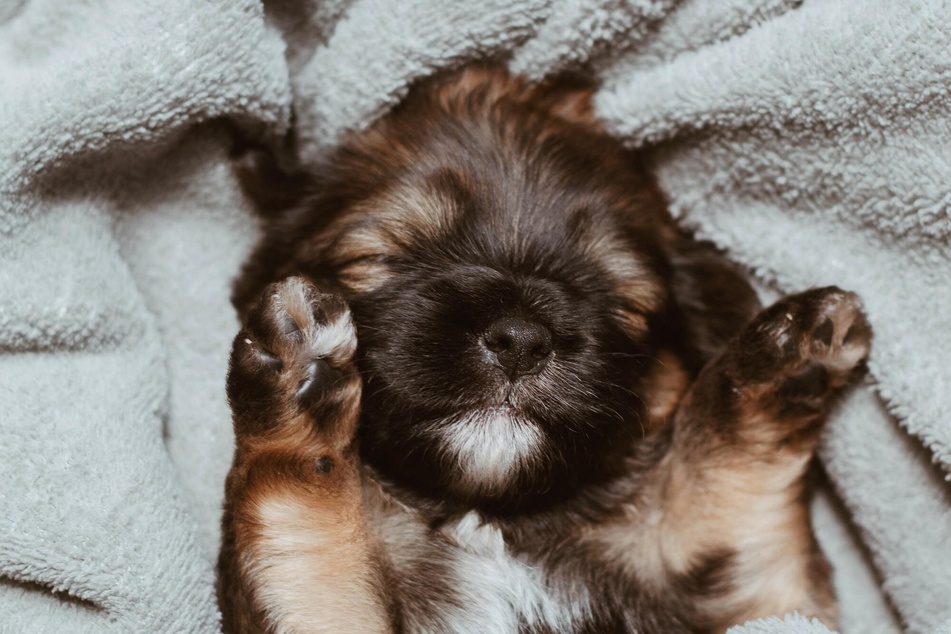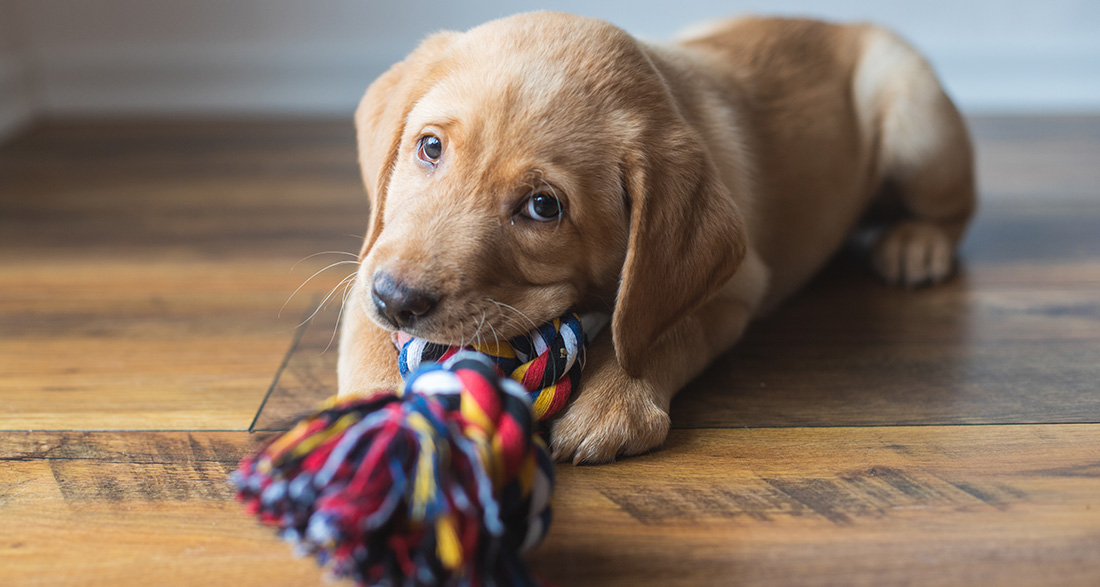He’s irresistibly cute but has a mischievous side! The initial period with a puppy can be quite stressful. Below, you’ll find helpful tips & tricks for successful puppy training!
Whether you’re getting a puppy from a breeder or adopting one from a shelter, the first days are exciting for both owners and dogs alike. It’s crucial to establish clear boundaries in training right from the start.
Young dogs are very curious and quick learners, so owners should begin puppy training as early as possible. However, the little pup should never be overwhelmed or strained during this process.
To prevent your four-legged friend from soon running the show, use the first days in the new home for playful explorations with treat rewards, for example.
But training puppies requires skill, and that’s why the iHugDogs Guide is here to answer the most important questions about your little furball.
1. Can the puppy sleep in bed?
Especially in the puppy stage, it’s hard to resist spending time with your new little companion. The decision to bring the adorable furball into bed for cuddles and sleep seems natural. However, this choice can turn out to be a serious mistake. Why should the dog understand in adulthood why it suddenly can’t sleep next to you?
Once larger dog breeds are fully grown, there might not be enough space in bed. iHugDogs reveals how to do it right!
- It’s essential to establish firm sleeping habits during puppy training.
- Ensure that the puppy feels comfortable and secure in its own bed.
- Place the bed in a quiet corner of your bedroom, where you can always keep an eye on the puppy.
- Your presence and familiar sounds will help the puppy feel comfortable and secure in its bed.
Patience, love, and calmness are crucial in puppy training.
It may take a few nights for the puppy to stop whining or waking you up. When getting a puppy, consider taking a few days off to be there for your pet, especially during sleepless nights.
2. How do I potty train my puppy?
In addition to a consistent sleep routine, you should also accustom the puppy to regular walks. iHugDogs reveals how:
- Establish fixed walking times: Choose the same times every day for short walks with your puppy (e.g., after waking up, midday, in the afternoon, and before bedtime).
- Puppies usually need to go out every two to three hours.
- Bring the puppy to a quiet spot, especially at the beginning, where it can relieve itself undisturbed.
- Plan time and patience: It may take a few days or weeks for the puppy to become completely potty trained.
- “Accidents” can happen, especially at night.
- Use padded or washable pads for the puppy’s bed.
Puppy training is mainly about not intimidating or frightening the little dog. So, instead of scolding your puppy if it does its business inside, praise it even more when it goes outside and reward it with an extra treat.

3. How can I get my puppy to walk on a leash?
Practice makes perfect in puppy training. It’s advisable to accustom the young dog to a harness, collar, and leash early on. Here’s how:
Tip 1: The right harness
If your puppy doesn’t like wearing a collar or plays with it, practice putting on and taking off the harness and walking on the leash more often indoors.
Tip 2: The first steps together
Leash handling is crucial for the puppy to recognize who is taking whom for a walk. So, set boundaries early on and don’t let the puppy, no matter how cute, get away with everything. The dog should adjust its pace to the owner’s during walks and not the other way around. It’s recommended to continue walking with the dog only when the leash remains loose. If the dog pulls and tugs in any direction, the owner should stop. The walk can resume only when the leash is loose again.
Tip 3: The owner needs to learn too
A secure leash walk requires a confident dog owner. Not for nothing is the leash called the “umbilical cord” between the dog and its owner, transmitting the owner’s uncertainties to the dog. Therefore, especially in puppy training, it’s crucial to provide the dog with security and set boundaries.
4. What commands should my puppy learn first?
The best command for puppy training is simply “No.” This signals to the young dog from the beginning that it shouldn’t do something, such as jumping on the sofa or bed. Other helpful commands are “Come,” “Sit,” “Down,” and “Stay.”
But how do you get your puppy to listen to these commands?
Tip 1: The right timing
The correct timing is crucial. For puppy training, it’s recommended to have a maximum of five minutes of training time with lots of sleeping and playing in between. Train the commands more often and incorporate the exercises into the dog’s daily routine in a playful way.
Tip 2: Treats & praise
To make training enjoyable for your puppy, treats and praise are essential. If your furry friend performs a command within three seconds, reward it immediately with its favorite snack. The shorter the time between the correct execution of the command and giving the treat, the better. This way, your puppy can remember the connection between the task and the reward.
Tip 3: The right motivation
Choose your puppy’s favorite snack to increase its motivation. Alternatively, you can use praise or the puppy’s favorite toy as a reward.
Expand puppy training gradually, increasing the duration and difficulty of the exercises over time.

5. How do I teach my puppy social behavior?
To ensure that nothing disturbs your dog’s peace, it’s essential to start socializing early.
Stress factors for puppies:
- other dogs
- playing or screaming children
- loud everyday noises
- vacuum cleaner, washing machine, TV
- escalators, street sweepers, trams, and trains
At the beginning, puppies are always overwhelmed by new impressions. Therefore, you should gradually introduce the young dog to its new environment.
The solution:
The best approach is to introduce the puppy daily to a new aspect of its “noisy home.” Puppy training requires patience and lots of love here too. Daily walks can also be used for small explorations. From escalators and bicycles to cats and dogs: Discover something new with your puppy every day. But be cautious! Your puppy also needs regular quiet and rest times to process the many sensory impressions.

Conclusion:
The initial period with a puppy is full of surprises and unforgettable moments.
If you are consistent in puppy training, teach the little dog the first commands early but gradually, and set and maintain boundaries (such as regarding the sleeping place), you and your dog will quickly become an unbeatable team.


